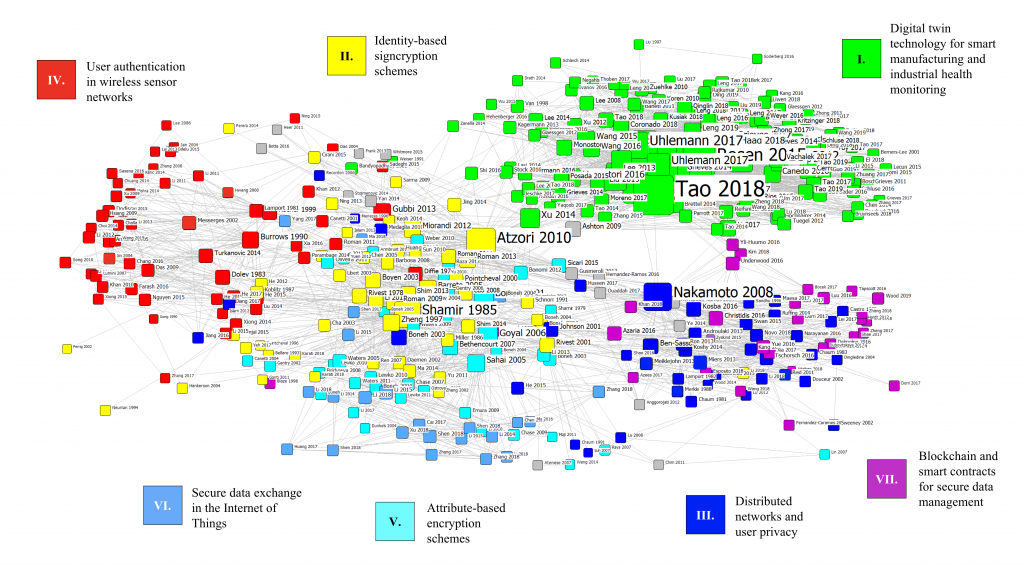Results of a Bibliometric Analysis on Digital Identity: Significant Publications, Research Flows, and Contexts
By Lennart Ante
Digital identities provide a basis for trustworthy transactions between two or more parties. By means of a digital identity, persons, objects or systems can identify themselves to other parties in order to prove the authenticity of their information. For example, identification information, access authorizations or messages can serve as proof.
Nowadays, a large number of transactions are conducted digitally. This makes traditional face-to-face identity confirmation more difficult or, in many cases, impossible. Furthermore, the fact that one or both parties to transactions are objects or systems leads to a high degree of complexity, which is a major challenge for digital identity systems.
Having said this, we have conducted a bibliometric analysis on the topic of digital identities and would like to present our findings on significant publications, research streams and contexts in the following.
Research on the topic of Digital Identities has existed for several decades. For example, Cameron (2005) highlighted that the Internet lacks the essential capability of an identity layer, which has led to numerous workarounds in the past. According to Allen (2016), four evolutionary steps of online identity management exist:
- Centralized identities (e.g., IANA, IP addresses).
- Federated identities (e.g., Google login button).
- User-centric identities, where identities are managed individually or across multiple entities.
- Self-sovereign identities, where users have full control over their data.
Against the background of the rapid growth of research on the topic of digital identities as well as the simultaneously increasing importance of technologies, such as blockchain or digital twin, the presented study pursues the goal of scientifically processing, summarizing and analyzing the existing findings.
In our study, “A bibliometric review of research on digital identity“, we identified research streams and emerging trends in academic research on digital identity through a bibliometric analysis of 1,395 peer-reviewed articles and their 44,412 references. From this, we derived seven distinct research streams and their relationships using a co-citation analysis. The analysis led to seven main research streams, which we briefly describe and summarize below:
- Digital twin technology for smart manufacturing and industrial health monitoring.
- Introduction and overview of the digital twin concept.
- Requirements, challenges, benefits, and guidelines for digital twin technology
- Cyber-physical system prognostics and health monitoring (e.g., aircraft, wind turbines, vehicles)
- Identity-based signature encryption techniques
- Identity-based signatures, encryption and signature encryption methods.
- Distributed networks and user data
- Technical foundations of distributed systems, peer-to-peer networks, and blockchains
- Extent of user privacy and anonymity in the Bitcoin network
- User authentication in wireless sensor networks
- Authentication schemes in wireless sensor networks (e.g., BioHashing, elliptic curve cryptography)
- Application-specific schemes (e.g., wireless body area networks (WBANs), telecare medical information systems (TMIS)).
- Attribute-based encryption schemes
- Attribute-based signatures and encryption schemes
- Secure data exchange in the Internet of Things
- Security and privacy of data transmission
- Schemes for data deduplication
- Secure data sharing and access control
- Encryption schemes for data movement and outsourcing
- Blockchain and smart contracts for secure data management
- Blockchain and smart contracts for secure and scalable data-driven applications, storage, sharing and management
- Thematic focus on healthcare, medical and pharmaceutical industries.

Interrelations of research streams
In the context of summarizing the seven research streams and their most significant publications, we aim to provide the reader with a holistic overview and fundamental understanding of the broad and complex field of Digital Identities. In addition, the insights generated from our study can be used to generate approaches for future research from the significant publications. This can reduce search costs for researchers and users and provide significant impetus.
We hope that the results of our systematic and comprehensive literature review will provide you with valuable insights into the development of the many research topics in the field of digital identity and help you to consider them in an appropriately nuanced way. The Internet may have been built without an identity layer, but researchers are working hard to change that.
You can download the full study, “A bibliometric review of research on digital identity” here. If you are interested in a joint exchange or project on the topic with us, we would be happy to hear from you.